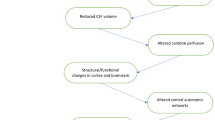Abstract
Ciclotropium is a recently developed parasympathicolytic agent. Plasma concentration and heart rate increase (the most prominent anticholinergic effects) were measured in 12 healthy subjects before, during and after a 15-min intravenous infusion of 10 mg ciclotropium. The effect was described by using either a linear or a nonlinear (E max) effect model linked to a linear three-compartment kinetic model via an effect compartment.
Maximum heart rate increase was 33 (10) beats·min−1, and half-value duration of effect was 41 (9) min. Total plasma clearance was 0.51 (0.13) l·min−1, and mean terminal elimination half-life was 12 (4) h, whereas the equilibration half-lives of drug removal from the effect compartment ranged from 2 to 14 min.
Similar content being viewed by others
References
Möller J, Rosen A (1968) Comparative studies on intramuscular and oral effective doses of some anticholinergic drugs. Acta Med. Scand 184: 201–209
Schladitz-Keil G, Spahn H, Mutschler E (1986) Determination of the bioavailability of the quaternary compound trospium chloride in man from urinary excretion data. Drug Res 36: 984–987
Liebmann B, Ding RW, Weber E, Mutschler E, Spahn-Langguth H, Langguth P (1994) Pharmacokinetics of ciclotropium in humans: rate and extent of absorption after oral administration. Biopharm Drug Dispos (submitted for publication)
Hinderling PH, Gundert-Remy U, Schmidlin O, Heinzel G (1985) Integrated pharmacokinetics and pharmacodynamics of atropine in healthy humans. II. pharmacodynamics. J Pharm Sci 74: 711–717
Roberts JB, Breckenridge AM (1977) Drugs affecting autonomic functions. In: Dukes MNG (ed) Meyler's side effects of drugs, vol 8, 2nd edn. Excerpta Medica, Amsterdam, pp 304–330
Heuer H, Gülker H, Frenking B, Bender F (1983) Klinischelektrophysiologische Befunde zur Wirkung von Ciclotropiumbromid auf bradycarde Herzrhythmusstörungen. Z Kardiol 72 [Suppl 2]: 76
Liebmann B, Henke D, Spahn-Langguth H, Mutschler E (1991) Determination of the quaternary compound ciclotropium in human biological material after hydrolysis and derivatization with the fluorophor flunoxaprofen chloride. J Chromatogr 572: 181–93
Liebmann B, Mayer S, Mutschler E, Spahn-Langguth H (1992) Studies on the metabolic clearance of ciclotropium to α-phenylciclo-pentyl acetic acid using a new enantiospecific metabolite assay. Drug Res 42: 1354–1358
Benet LZ (1972) General treatment of linear mammilary models with elimination from any compartment as used in pharmacokinetics. J Pharm Sci 61: 536–541
Gibaldi M, Perrier D (1982) Pharmacokinetics, 2nd edn. Dekker, New York, p 93
Sheiner LB, Rosenberg B, Marathe VV (1977) Estimation of population characteristics of pharmacokinetic parameters from routine clinical data. J Pharmacokinet Biopharm 5: 445–479
Whiting B, Holford NHG, Sheiner LB (1980) Quantitative analysis of the disopyramide concentration-effect relationship. Br J Clin Pharmacol 9: 67–75
Holford NHG, Sheiner LB (1981) Understanding the dose-effect relationship: Clinical application of pharmacokinetic-pharmacodynamic models. Clin Pharmacokinet 6: 429–453
Holford NHG (1988) MKMODEL. An extended least squares modelling program. Biosoft, Cambridge, UK
Herxheimer A, Haefeli L (1966) Human pharmacology of hyoscine butylbromide. Lancet II: 418–421
Kalser SC, McLain PL (1969) Atropine metabolism in man. Clin Pharmacol Ther 11: 214–227
Kanto J, Klotz U (1988) Pharmacokinetic implications for the clinical use of atropine, scopolamine and glycopyrrolate. Acta Anaesthesiol Scand 32: 69–78
Author information
Authors and Affiliations
Additional information
Died on 7 December 1992
Rights and permissions
About this article
Cite this article
Ding, R.W., Port, R.E., Ortmann, K. et al. The effect of ciclotropium on human heart rate. Eur J Clin Pharmacol 46, 455–459 (1994). https://doi.org/10.1007/BF00191911
Received:
Accepted:
Issue Date:
DOI: https://doi.org/10.1007/BF00191911




